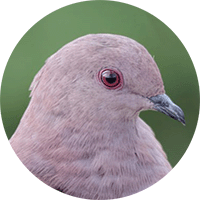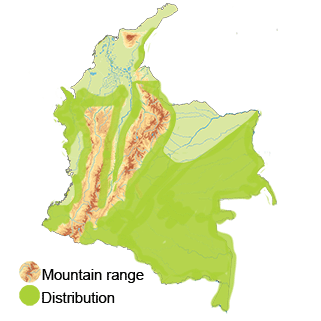Ruddy Pigeon
The Ruddy Pigeon (Patagioenas subvinacea). Read in Spanish
Appearance: The Ruddy Pigeon is a medium-sized pigeon with a distinctly ruddy or reddish-brown plumage, which is more vibrant in males. It has a lighter grayish color on the head and neck, contrasting with the ruddy body plumage. This pigeon species has a relatively short tail and a reddish or grayish bill. Ruddy Pigeons are generally monomorphic, meaning that males and females have similar plumage.
Habitat: The Ruddy Pigeon inhabits various forested habitats, including humid tropical forests, montane forests, and cloud forests. The Ruddy Pigeon can be found in regions with suitable forest cover, ranging from lowland areas to higher elevations in the Andes.
Behavior: Ruddy Pigeons are typically shy and elusive birds that spend much of their time foraging quietly in the forest understory. They are known to feed on fruits, seeds, and possibly insects found in their habitat. Ruddy Pigeons may form small groups or pairs, moving through the forest in search of food and suitable nesting sites.
Breeding: Breeding habits of the Ruddy Pigeon likely involve the establishment of territories, courtship displays, and nest-building activities within their forest habitat. They construct simple nests made of twigs and leaves in trees or shrubs, where they lay one or two eggs per clutch. Both parents likely participate in incubating the eggs and caring for the young until they fledge.
Conservation Status: The conservation status of the Ruddy Pigeon in Colombia may vary depending on the specific regions and habitats where it occurs.
Distribution
The Ruddy Pigeon (Patagioenas subvinacea) is a species of pigeon found in various countries in Central and South America, including Colombia.
Andean Region: The Ruddy Pigeon can be found in the Andean region of Colombia, which includes the mountainous areas along the Andes mountain range. This region consists of diverse habitats ranging from high-altitude cloud forests to lower elevation woodlands and agricultural areas where the Ruddy Pigeon may occur.
Amazon Region: Parts of Colombia, especially in the southern and southeastern regions, are part of the Amazon Rainforest basin. The Ruddy Pigeon can be found in the Amazon region, primarily in forested areas with a dense canopy and rich biodiversity.
Pacific Coast: The Ruddy Pigeon is also likely to be present in the Pacific coastal region of Colombia, where a combination of mangroves, tropical forests, and coastal habitats provide suitable environments for this species.
Orinoco Region: The Orinoco River basin in Colombia, which covers eastern parts of the country, also provides habitat for the Ruddy Pigeon. Forested areas along the river and its tributaries are potential locations where this species can be observed.
Caribbean Region: In the northern part of Colombia, along the Caribbean coast and the Sierra Nevada de Santa Marta mountain range, the Ruddy Pigeon may be found in various habitats, including tropical forests and montane areas.
Taxonomy
The Ruddy Pigeon (Patagioenas subvinacea)
- Kingdom: Animalia
- Phylum: Chordata
- Class: Aves (Birds)
- Order: Columbiformes
- Family: Columbidae
- Genus: Patagioenas
- Species: Patagioenas subvinacea
Vocalization
The Ruddy Pigeon (Patagioenas subvinacea) is known for its distinctive and melodious vocalizations.
The vocal repertoire of the Ruddy Pigeon is used for a variety of purposes, including:
- Communication: The cooing calls of the Ruddy Pigeon help individuals communicate with each other within their social groups. These vocalizations can signal the presence of a mate, establish territory boundaries, or communicate distress or alarm.
- Courtship: During the breeding season, male Ruddy Pigeons may use their vocalizations as part of their courtship displays to attract females. The soft coos and calls may be accompanied by visual displays such as puffing up their feathers or bowing movements.
- Parental Care: Ruddy Pigeon parents may use specific vocalizations to communicate with their offspring. This helps maintain contact between parents and chicks, especially when foraging or moving through dense vegetation.




